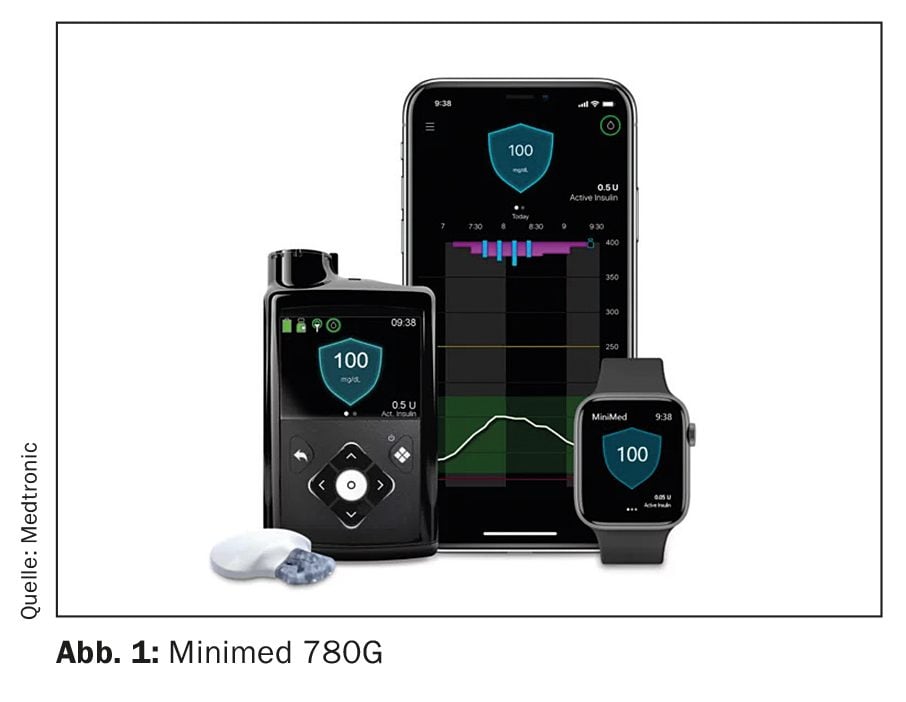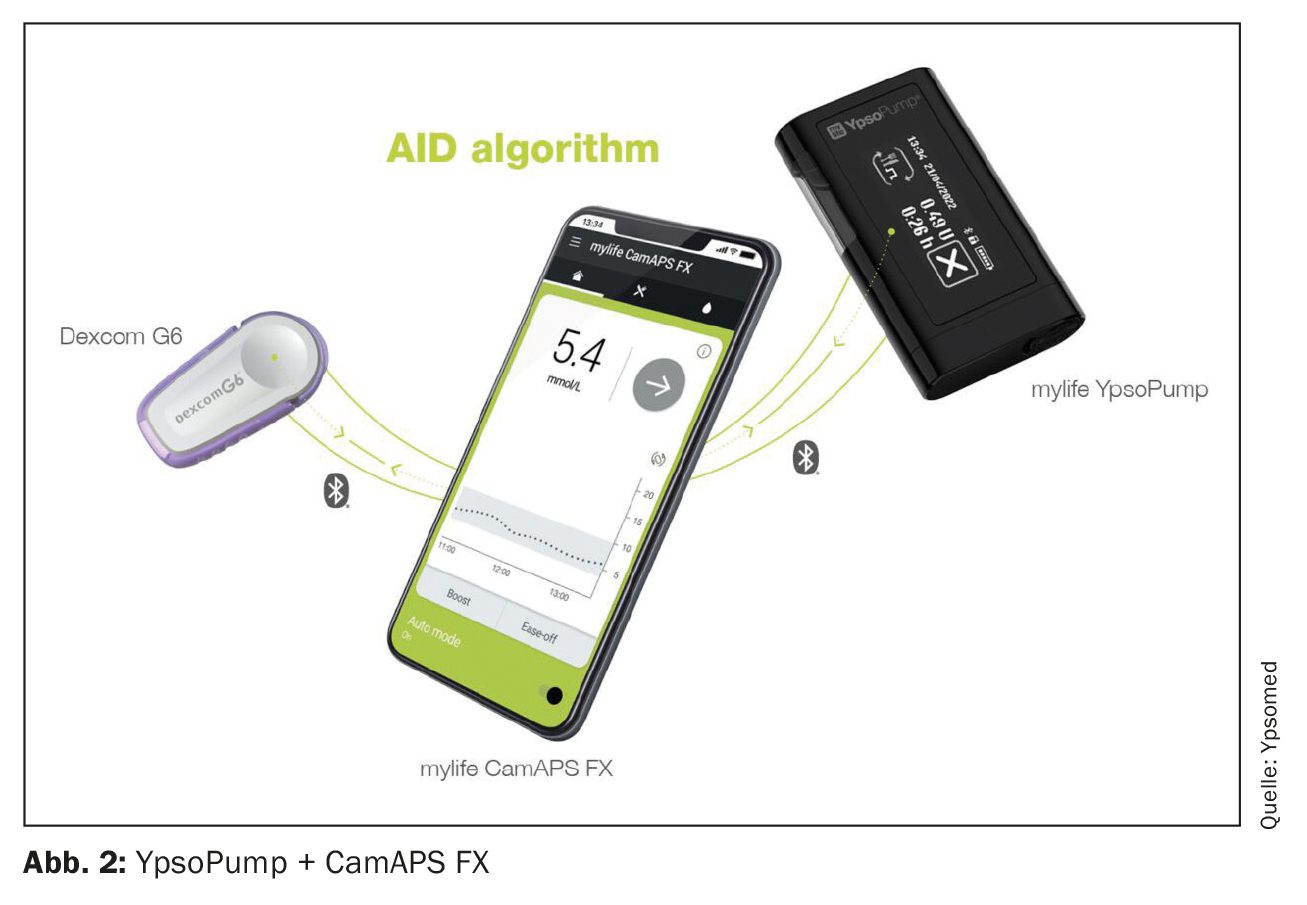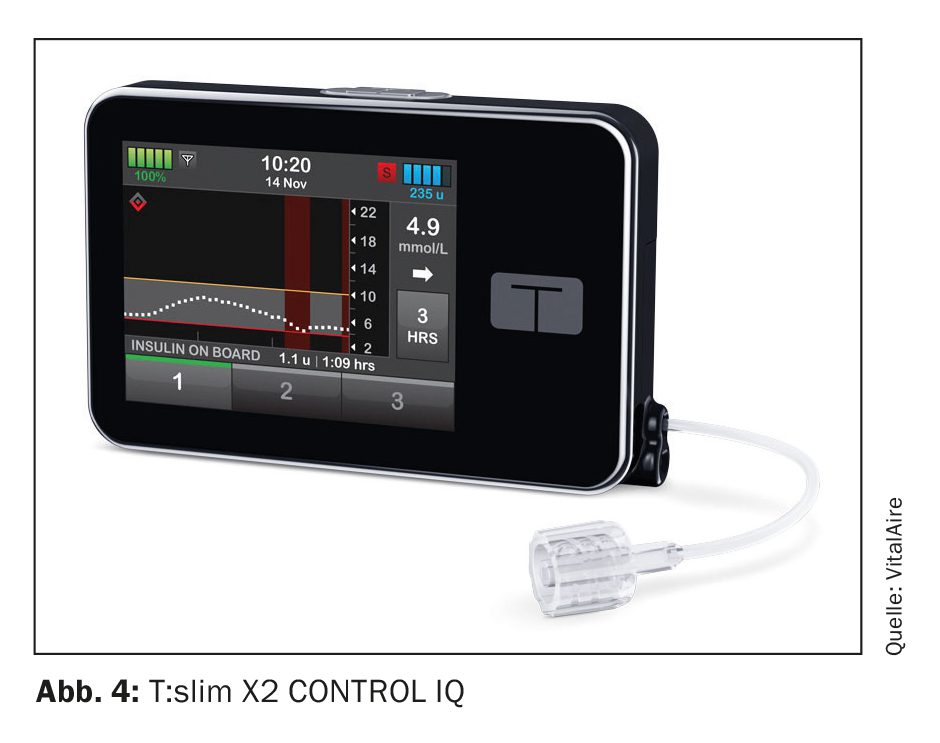Diabetes technology has developed rapidly in recent years. Tools such as insulin pumps, CGM systems and now AID systems (also known as closed-loop systems) have become indispensable in pediatric diabetology and are now standard therapy in Switzerland.
You can take the CME test in our learning platform after recommended review of the materials. Please click on the following button:
Diabetes technology has developed rapidly in recent years. Tools such as insulin pumps, CGM systems and now AID systems (also known as closed-loop systems) have become indispensable in pediatric diabetology and are now standard therapy in Switzerland.
An AID system (Automated Insulin Delivery) consists of three components: a system for continuous glucose measurement (rtCGM), an algorithm (calculation program) that calculates the amount of insulin based on the glucose values, and an insulin pump that then delivers the insulin dose automatically. The systems are based on the basic principle of semi-automated insulin delivery. They differ in the individual algorithms and above all in the input and control options. More and more AID systems are coming onto the German-speaking market, all with the aim of improving metabolic control and the quality of life of young and old patients and their families. The way to achieve this differs, but the goal is the same for all systems. However, there are a few key points to consider and discuss with patients/families.
Several AID systems are currently available for pediatrics and will be presented in detail.
Minimed 780G
The Minimed 780G AID system from Medtronic consists of the insulin pump, the Guardian 3 or Guardian 4 sensor and an algorithm that is localized in the pump (Fig. 1). The algorithm is a “mixture” of PID (proportional integral derivative), insulin feedback and fuzzy logic. The sensor wear time for both sensors is 7 days, the Guardian 3 sensor must be calibrated at least twice a day, the Guardian 4 sensor can, but does not have to be calibrated. The glucose target values can be individually selected between 100 mg/dl, 110 mg/dl and 120 mg/dl, but are then set for 24 hours. Different target values for different times of day cannot be set. Of course, the target value can be changed by the user at any time.
An automatic basal adjustment is made every five minutes by the adaptive basal insulin delivery in order to reach the target value. This means that a microbolus of insulin is calculated by the algorithm according to the sensor glucose level and delivered by the insulin pump. Five minutes later, the same thing happens again. If the sensor glucose is >120 mg/dl despite maximum basal insulin delivery, a correction bolus is automatically delivered by the algorithm. Safety mechanisms/restrictions prevent overdosing and excessive insulin delivery.
The approval restrictions must be taken into account when prescribing/prescribing: The insulin pump is approved from an age of ≥7 years and a total daily dose (TDD) of ≥8 IU. Approved insulins are Humalog and Novorapid U100. Adjustment screws to optimize the setting: AI ratio (KH factor) and time-active insulin, target values, NO change of basal supply by the user, as this is determined by the algorithm. Temporarily (sport, illness, low demand) the target value can be set to 150 mg/dl (8.3 mmol/l). The glucose data/insulin pump data can be uploaded to the cloud using a smartphone or read-out stick and can then be accessed by users and practitioners web-based via Carelink (Personal versus Professional) and a therapy discussion and adjustment is also possible via telemedicine.
YpsoPump + CamAPS FX
To be able to use the YpsoPump + CamAPS FX AID system, you need the YpsoPump from mylife, an rtCGM and a smartphone with an Android operating system (before purchasing, we recommend that you first take a look at the compatibility lists of the rtCGM manufacturers) (Fig. 2).
With the rtCGM, there is a choice between a DexCom G6 from DexCom and a FreeStyle Libre 3 from Abbott. The differences between the available rtCGMs are not only in their size, but also in the wearing time (DexCom G6 = 10 days, FreeStyle Libre 3 = 14 days). The most important difference, however, is the age from which the rtCGMs are approved. While the DexCom G6 can be used from the age of 1, the FreeStyle Libre 3 can only be used from the age of 4.
In addition to the hardware (YpsoPump, rtCGM and smartphone), the “CamAPS FX” app is also required, which can be downloaded from the Google Playstore. Please note that CamAPS FX can only be used with a personal code. This code will be provided as soon as a corresponding certification for CamAPS FX has been carried out.
It is an MPC-based algorithm (treat-to-target), an adaptive system that uses the current sensor value, the glucose change rate, the most recent therapy information, the TDD, the body weight and the learning history to create a progression forecast and calculate the insulin administration. The calculated insulin is delivered as an extended bolus over a period of 30 minutes, with a new calculation including bolus adjustment taking place every 8-12 minutes. Due to the material composition of the reservoir, all U-100 analogs and diluted insulin can be used here.
Values between 80 mg/dl and 200 mg/dl can be selected as the glucose target in up to 48 time blocks; the preset target is 104 mg/dl. The AI ratios (KE/BE factors) and correction factors can also be divided into 48 time blocks. The delivery of meal and possibly correction boluses takes place via the app.
To support therapy in special situations, the app also offers the choice between the two modes “Ease off” and “Boost”. Ease off” reduces the aggressiveness of the algorithm and increases the entered glucose target by 45 mg/dl, while “Boost” increases the aggressiveness of the algorithm by 30%.
Another feature is the option to enter “slowly absorbable meals”, which is useful as soon as meals with a high FPE content are consumed.
The parameters for optimizing the setting are AI ratios (KE/BE factors), body weight, glucose target values as well as the “Ease off” and “Boost” modes for temporary optimization. Changing the basal rate in no way contributes to optimization, as this is only stored in the pump as a “drop net” and is not taken into account in the calculations.
The data is transmitted via the web-based “Glooko” app, which also offers the option of telemedical therapy adjustment. The prerequisite for this is that both the patient and the treating team have a user account.
The Ypsopump and CamAPS FX are approved from the age of 1 year, and this is the only AID system available on the market that is approved for pregnant women. Nevertheless, there are also approval restrictions here: Even if CamAPS FX is approved from the age of 1 year, this does not also apply to the rtCGMs (see information regarding the rtCGM at the beginning); a TDD of ≥5 IU must also be given so that the algorithm can work adequately.
Omnipod 5
This hybrid AID system consists of a pod, the controller and the Dexcom G6 sensor (Fig. 3). The Dexcom G6 sensor has a wear time of 10 days and does not need to be calibrated. In order to receive alerts (for low or high glucose values), it is advisable to use a compatible smartphone (directly). This SmartAdjust technology works with an MPC algorithm and is integrated in the pod. All relevant data is stored in the controller and transferred to the next pod via Bluetooth each time the pod is changed. This means that each pod can continue to work/deliver insulin even if the controller is not nearby. The pod receives Dexcom CGM values directly from the CGM transmitter and then sends them to the controller.
The glucose target values can be set individually between 110-150 mg/dl in steps of 10 and at different times of day (eight segments per day). The user has the option of changing these at any time.
As of 11/2024, the Omnipod 5 is not yet approved in Switzerland (neither for adults nor children). The manufacturer expects approval for Switzerland in spring 2025, but the system will be presented here due to its characteristics. The special feature of this system is that the first two pods are so-called “learning pods”. This means that the first pod uses the manually entered basal rate to estimate the total daily insulin dose and determine the initial basal rate. In doing so, the system plays it safe and initially delivers a maximum dose very cautiously. The second Pod uses the total insulin delivery history (basal+bolus) to calculate and update the basal boluses to be delivered. Now the maximum basal delivery is no longer restrained. For all subsequent Pods, the adaptive basal rate is updated at each Pod change based on the total daily insulin dose. The insulin delivery is calculated every five minutes. The calculation is based on the expected glucose value 60 minutes in advance, the current glucose value and trend, the active insulin and the insulin delivery history.
To optimize therapy, the glucose target values, the AI ratio to meals, the correction factors (influences bolus delivery), the threshold value for bolus calculators and the insulin action time (only influences bolus) can be changed or adjusted in AID mode. In special situations, such as ketoacidosis or illness, you can switch directly to “Manual mode”.
It is possible to activate the activity function, e.g. during sport/increased exercise. During this period, the glucose target is raised to 150 mg/dl and reduces automatic insulin delivery.
The Omnipod 5 can be prescribed for ≥2 years and is approved for NovoRapid, Humalog and Insulin Lispro Sanofi U100 in the EU. However, it should be noted that the system requires an average total daily insulin dose of ≥5 IU.
Glucose data/insulin pump data is transferred to the web-based glooko program using the pod ID (sim card in the controller). Users are asked by the company insulet to create an account with glooko before the system is set up. This means that therapy discussions and adjustments can also be made via telemedicine if the practice is equipped accordingly.
T:slim X2 CONTROL IQ
The AID system t.slim X2 with Control-IQ from VitalAire consists of the insulin pump and the Dexcom G6 sensor (Fig. 4). The algorithm, which is localized in the pump, consists of a mixture of PID and MCP (model-predictive control algorithm). The Dexcom G6 sensor has a wear time of ten days and does not need to be calibrated. In auto mode, the target value is 110 mg/dl over 24 hours and cannot be changed. The insulin action time is set to five hours in the pump and cannot be changed.
The automatic basal adjustment takes place every five minutes to reach the target value. The adaptive basal insulin delivery is calculated from the CGM value + correction factor + active insulin + CGM value in 30 minutes + stored basal rate. In order to avoid overdosing, the maximum delivery quantity for an automated basal rate increase is 50% of the TDD within two hours. An additional correction bolus can be made automatically 60 minutes after manual bolus delivery if the limit value is exceeded. This is possible once per hour. This delivery amounts to a maximum of 60% of the total correction bolus and is calculated from the current correction factor (from the profile) + CGM value in 30 minutes + active insulin + total daily dose (TDD). For safety reasons, the maximum delivery is limited to six units.
The insulins that can be used in the pump are Humalog U100 and Novo Rapid U100. When prescribing, it should be borne in mind that the system is only approved from the age of six, a weight between 24 and 140 kg and an average total daily dose of 10 to 100 units of insulin.
Possible parameters for optimizing the setting are AI ratio, stored basal rate, correction factor. The system allows you to activate two modes: activity (for sport/movement) and sleep. During bolus delivery, it is possible to use an extended bolus (max. two hours). The battery is charged using the power cable supplied.
The insulin pump data/glucose data is read out by connecting the pump by cable to a PC where the user has previously downloaded and registered the web-based program Glooko. This makes it possible to carry out a therapy discussion/adjustment via telemedicine.
Conclusion
With an AID system, the time in target range (TiR) improves and leads to lower HbA1c values. Furthermore, there are fewer glucose fluctuations and a reduction in hypoglycaemia. Families, children and adolescents experience quieter nights and a more relaxed atmosphere. The use of the AID systems relieves children and adolescents with type 1 diabetes in their therapy management and gives the family back more quality of life.
To ensure these successes, good training is one of the prerequisites for this, in which an emergency plan in the event of technical failure should also be discussed in all cases. It is important to pay attention to the approval criteria (age, insulins, total daily dose, etc.) of the individual systems before prescribing and to discuss this with the user. The expectations of the system and what is possible and achievable must be clarified before the pump is used.
Take-Home-Messages
- Studies show that the clinical results of the AID systems are comparable.
- With an AID system, the TiR and HbA1c values improve. There are also fewer glucose fluctuations and a reduction in hypoglycemia.
- Good training is a prerequisite, as is an emergency plan in the event of technical failure.
- Approval criteria (age, insulins, total daily dose, etc.) of the individual systems must be observed before prescribing. The expectations of the system must be clarified with the user before the pump is used.
InFo DIABETOLOGY & ENDOCRINOLOGY 2024; 1(4): 6-9















